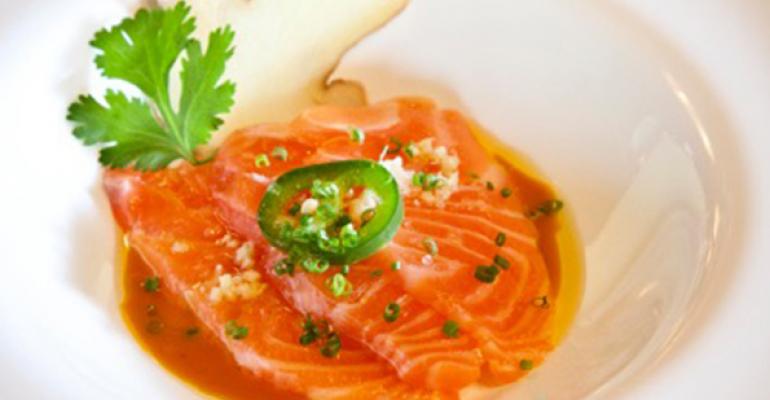When wild salmon season begins in mid-summer, king, or Chinook, salmon will start jumping onto dinner plates at restaurants everywhere. But until this precious species becomes available, chefs are finding innovative alternatives to feed diners’ hunger for the full-flavored fish.
“The [wild] king salmon … it’s such an amazing product,” said executive chef Kevin Cuddihee of Two, a seasonal farm-to-fork restaurant in Chicago. “In the off-season, salmon is so popular we have to get creative.”
A few months ago, Cuddihee found a new way to keep salmon on his restaurant’s menu year round: Faroe Island salmon. Cuddihee says this salmon, farmed in the open waters between Scotland and Iceland, comes as close as you can get in terms of flavor to the coveted wild Alaskan salmon he will put on the menu come early summer.
“It’s a great flavor,” Cuddihee said, describing it as “a little on the lighter side than wild-caught, less oily, but meaty tasting.”

He currently pairs Scottish salmon with spring onion puree, wild mushrooms and fava beans.
Cuddihee isn’t alone. According to the most recent research from Datassential MenuTrends, Scottish salmon is the fastest-growing salmon variety, appearing on 25 percent more menus than just a year ago.
Patrick Owens, chef and owner of Langdon’s Restaurant and Wine Bar and Opal Restaurant and Bar in Charleston, S.C., is also a fan of Faroe Island salmon.
“There’s no lack of flavor with the Scottish,” Owens said. “It’s a great product cooked or raw.”
At Opal, Owens serves the salmon chile-glazed with local greens, heirloom carrots, almonds and pepperonata vinaigrette. At Langdon’s, he serves it orange-soy grilled with cucumber salad and aromatic jasmine rice, and as a crudo.
Owens likes the Scottish so much that he plans to keep it on the menu even with the arrival of the wild king, which he’ll run as a special.
When wild king salmon is plentiful, Ben Pollinger, executive chef of Oceana, will feature it both on its own as a simply prepared fish on the grill, or plancha, or in a summery, composed dish. Until then, he chooses to use Scottish salmon in the New York City-based seafood mecca for its high quality. Pollinger currently serves a Scottish Salmon Sashimi with togarashi and hearts of palm and a Scottish Salmon a la Plancha.
While Scottish salmon is most popular on fine-dining menus, some casual-dining and fast-casual chains have caught on to it as well.
At Snap Kitchen, a five-year-old Austin, Texas-based chain, Crispy Scottish Salmon, crusted with almonds and served with roasted carrots and zucchini, is on the menu.
Serafina Restaurants, with 10 locations in New York and Philadelphia, puts Scottish salmon on a pizza. The chain’s Al Salmone pizze, is topped with mozzarella, Scottish smoked salmon and dill.
Meanwhile, other chefs are giving diners their salmon fix by menuing either coho, silver salmon, or sockeye, red salmon.
After wild king season ends, chef and owner Erik Niel of Easy Bistro & Bar in Chattanooga, Tenn., turns to sockeye until about November, he said. He keeps both wild king and sockeye on his menu by freezing the collars and serving them year-round in dishes such as tempura-fried king salmon collar with white barbecue sauce; benne seed fried sockeye collar with matcha and Meyer lemon aioli, and chicken-fried sockeye salmon collar with wasabi buttermilk cream and wild watercress.
At Lumière in Newton, Mass., chef Michael Leviton has previously featured Bristol Bay sockeye salmon raw, as tartare, cured with lemon and herbs or smoked in a pâté. He says he prefers sockeye because he likes the “clean, clear flavor.”
Similarly, chef and partner Michael Serpa will use coho salmon for the salmon tartare at his soon-to-open Select Oyster Bar in Boston.
“Coho salmon’s beautiful color, soft texture, fat ratio and the fact that it’s not super oily ensures that it really lends itself well to crudos,” Serpa said, adding, “not to mention the price point is much lower than king salmon.”





